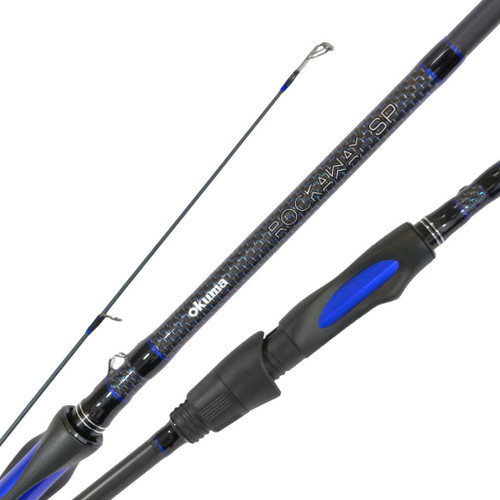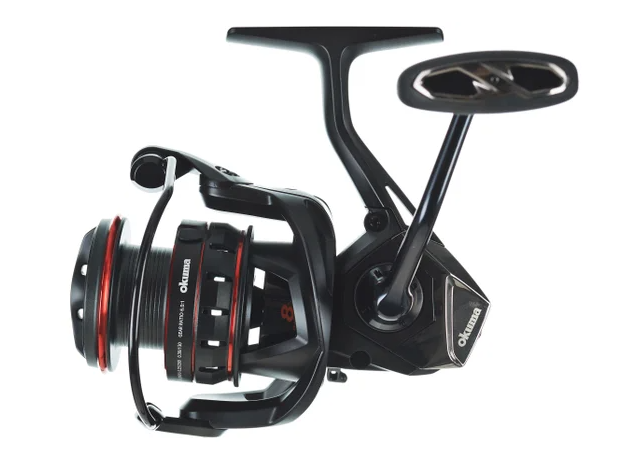Log in
News Post
-
Here are the 2019 Riptide Rendezvous Results!
 Photo by Michael Schweit
Photo by Michael Schweit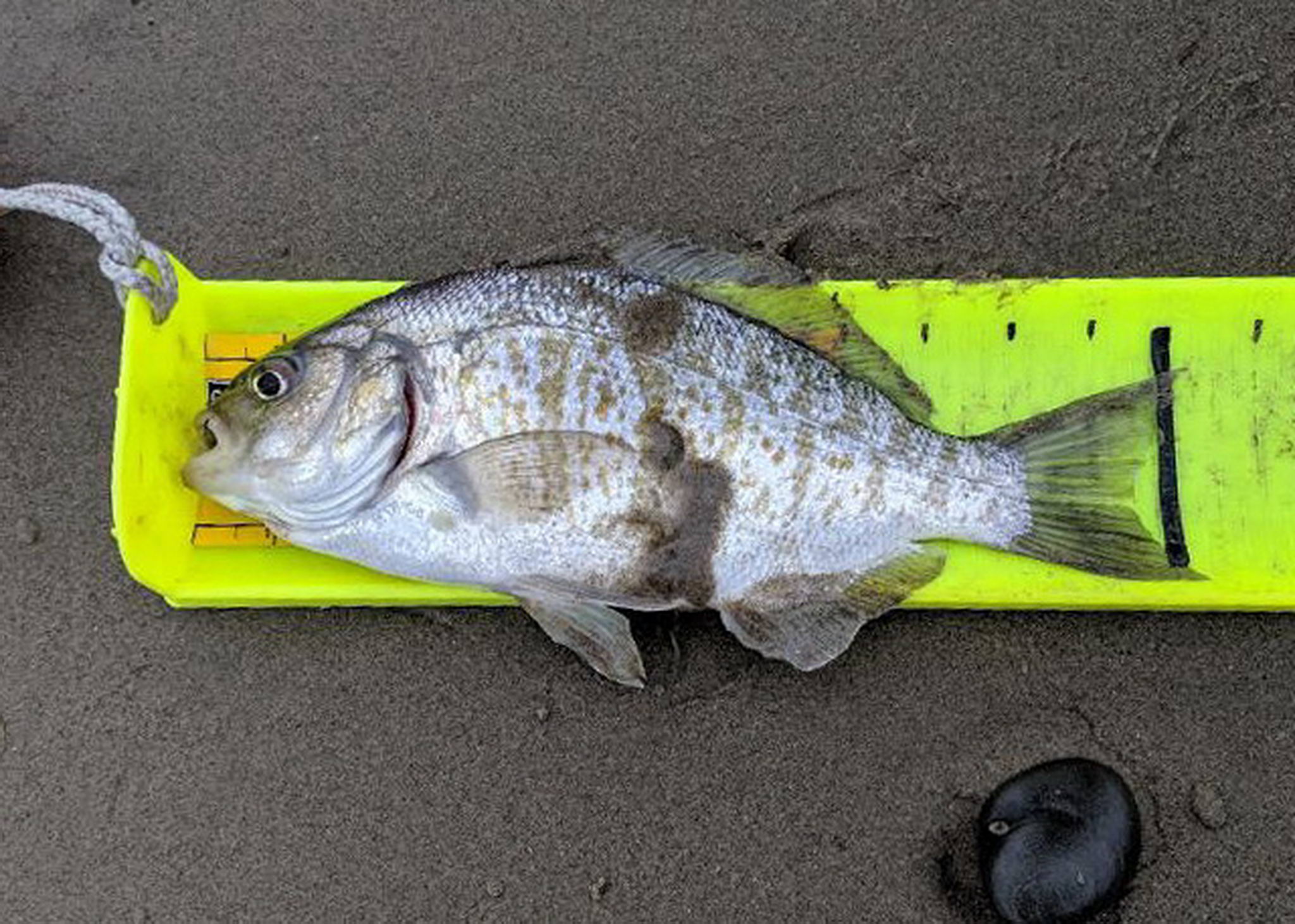 Photo from iAngler
Photo from iAnglerRiptide Rendezvous 2019 is in the books! And what a difference 18 months makes. We had 27 anglers (21 fly, 6 conventional), catching 92 Surf Perch and 1 corbina in the two-hour fishing window. There was a second Corbina caught on fly, but it was foul-hooked, so it didn't count. Quite a step up from the results from 2017...
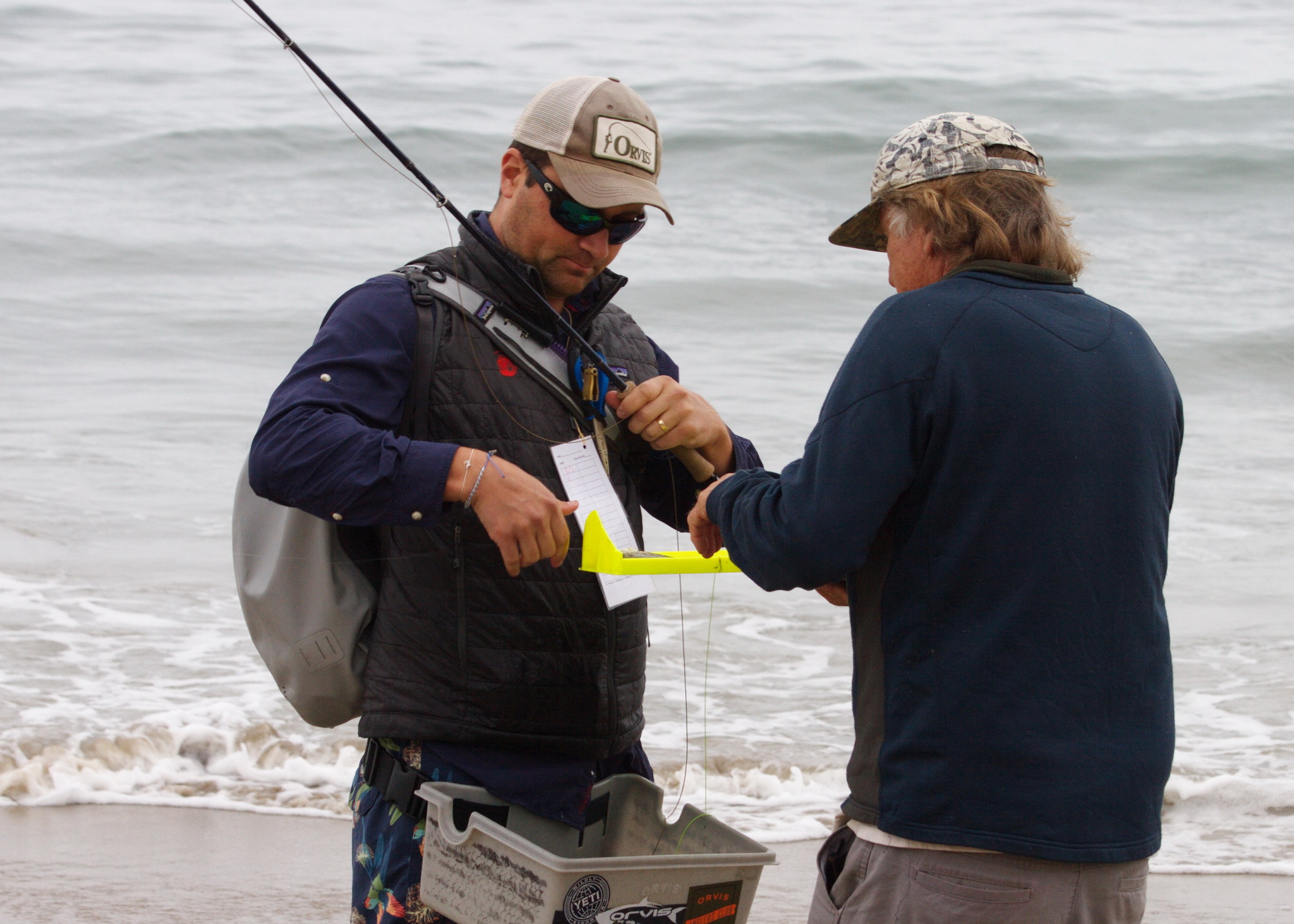 Photo by Michael Schweit
Photo by Michael SchweitWe relaxed the rules a bit for conventional tackle fishermen. Still artificial lures and C&R only, but the one-lure requirement was dropped. It didn't seem to make a difference, 69% of the fly fishermen caught at least one fish versus 50% of the conventional fishermen, and the Most Points fly guy caught more fish than the Most Points conventional guy.
And in a sign of how many fish there were (if you were in the right place), award-winning fly tyer Steve Fernandez actually lost his fly about 1 hour into it, yet still ended up with 3rd most points in the Fly Division ("Hi Steve, what are you doing back so soon? Oh, sorry...")
We also had two junior anglers in the Conventional Tackle division (John and Shaun Vague, Jr.), and the youngest angler (Shaun Vague Jr., age 12) caught the corbina!
Congratulations to the winners, and we hope we see you guys next year!
Here are the summary results:
1rst Fish Fly Angler/Tyer: Peter Van Hest / Jonathan Simle - 8:09am
Largest Fish Fly Angler/Tyer: Vince Narez / Mike Ogden - 12.25” Barred Surf Perch
Most Points Fly Angler/Tyer: Aaron Field / Steve Fernandez - 128.25 points.1rst Fish Conventional: Tiffany Vague - 8:22am
Largest Fish Conventional: Shaun Vague Jr. - 16.75” Corbina
Most Points Conventional: Wayne Tanouye - 112.50 points.Here are the full results:
Division Name Fly Tyer # Fish Points First Fish Largest Conventional Wayne Tanouye 17 112.50 Conventional Shaun Vague Jr 5 42.50 16.75" Corbina Conventional Tiffany Vague 1 6.50 8:22am Conventional John Vague - - Conventional Mas Kosaka - - Conventional Shaun Vague Sr - - Fly Aaron Field Steven Fernandez 19 128.25 Fly Peter Van Hest Jonathan Simle 16 111.25 8:09am Fly Steven Fernandez Mike Martin 7 47.50 Fly John Hansen Scott Brichan 7 45.50 Fly Ben Franken Andrew Slade 4 27.00 Fly Vince Narez Mike Ogden 3 25.50 12.25" Barred Surf Perch Fly Jonathan Simle Andy Malovos 3 23.00 Fly Rami Delos Reyes Aaron Field 3 20.50 Fly Mike Ogden Ben Franken 2 15.00 Fly Andrew Slade John Hansen 2 12.75 Fly Mike Miller David McIntosh 1 9.00 Fly Rob Talmadge Ruben Salcedo 1 7.00 Fly Mark Johnson Mike Miller 1 6.50 Fly Andy Malovos Jon Avery - - Fly David McIntosh Vince Narez - - Fly Jack Chang Michael Bowden - - Fly Jon Avery Rob Talmadge - - Fly Michael Bowden Mark Johnson - - Fly Mike Martin Jack Chang - - Fly Ruben Salcedo Peter Van Hest - - Fly Scott Brichan Rami Delos Reyes - - -
With Ken Baldwin, Interview by Matt Casado
Ken Baldwin has been a fisherman for more than 30 years. His love for fishing grew from his father who worked as a Game Warden, which ensured that Ken spent much of his time in the outdoors while growing up. After high school he went to the University of Washington where he played football and majored in Communications. Being a much better fisherman than football player he figured it was more realistic to make a living chasing fish than chasing a football. He guides and photographs for the Rainbow Bay Resort, a fly-in, full-service hunting and fishing lodge in Bristol Bay, Alaska.
We caught up with Ken in Los Angeles where he’s busy putting the final touches on his upcoming outdoor television show, “Season on the Edge,” which airs on the Destination Channel.
We visited with Ken to learn what it takes to catch the wild rainbow trout that Ken targets in Alaska. These rainbows run up to fifteen pounds and follow the great runs of sockeye salmon up rivers with names like Kenai, Illiamna and Nushagak.MC. How long have you been guiding in Alaska and how did you get started?
KB. This is my ninth year guiding in Alaska. My brother worked as a guide and he’s the one who got me my first job.
MC. In what part of Alaska do you guide?
KB. The Bristol Bay watershed in southwest Alaska, out of the Rainbow Bay Resort.
MC. And what species do you target?
KB. We target five species of salmon: kings, silvers, sockeyes, chums and pinks. We also go after rainbow trout, arctic char, dolly varden, grayling, pike and halibut.
MC. Which one’s the most fun?
KB. (laughs) The kings and the rainbows. We have folks who come specifically for the king salmon. They want just the kings. They want to catch them, fillet them and take them home. And that’s a very short season, two weeks, maybe a little more, starting in June. Then we have the folks who come strictly for the giant rainbows.
MC. Let’s talk about the rainbows. How do you target rainbows that follow the massive runs of sockeye salmon?
KB. Well, first off, there are three segments to a summer season of catching rainbows. One, we have the pre-salmon run. Then the actual salmon run comes, which is then followed by what we call the post-salmon run.
MC. So it’s all about the salmon.
KB. Right. Truth is it’s all about the salmon eggs. Salmon eggs make up the vast majority of the rainbow’s diet. At the beginning of the season the rainbows are skinny and hungry. By late September they’re fat and happy, and it’s the eggs that have made them fat and happy. By the end of the season they’ve had their fill and they become much more particular about presentation.
MC. Let’s talk about the beginning of the season.
KB. When the sockeye aren’t there you target the rainbows differently than when the sockeye are there. Like I said, they’ve just endured a long winter with not much to eat, so they’re hungry and aggressive.
MC. Now this is before the sockeye begin they’re trek up river?
KB. Right. There may be a few sockeye, but the major migration up river hasn’t happened yet. Now you can pretty much count on the sockeye showing up in numbers by July 4th, at least where we fish. Before that, obviously there aren’t any salmon eggs floating down river, so before the migration we target the rainbows with leech patterns, fry patterns and mouse patterns.
MC. Let’s talk equipment for a moment.
KB. Sure. For spin fishing we use a 9’6” rod with 10 lb. test monofilament line. We like the extra length because it allows for a better drift. My favorite is the Lamiglass, model G1367, which runs at around $170, but any well-built rod will do the job. It’s the length and heft that’s important. Any decent reel with 10 lb. test capacity is fine.
For fly fishing we outfit our clients with a TFO Clouser rod because it’s a good rod to throw weight. We’ll use a 6 weight, 9’ rod. The rod was designed by Bob Clouser to throw the Clouser minnow, which is a heavily weighted streamer. And any decent fly fishing reel with 6 weight capacity will do the job.
Now this isn’t traditional fly casting, it’s more like a “chuck and duck” thing. Just get that baby out there. The rod is relatively inexpensive, which is good for us because throughout a summer of fishing your rods are going to take a beating with a chance of breaking, so we leave our high-end rods at home.
These rainbows aren’t leader shy. We usually use about seven to eight feet of 10 lb. leader. No taper is needed.MC. Okay, tell us about technique.
KB. With the leeches we usually swing them. We’ll cast directly across stream or slightly down and across, then let the leech swing its way downstream. If you fish for steelhead you know this technique quite well.
We’re slowly stripping back as the leech reaches its furthest downstream position. We don’t want to strip it back all the way. When the leech reaches the end of the swing we want to pause and let the leech swim in the water. The majority of strikes occur as the leech is sitting there undulating in the current.
MC. And the fry? Actually, why don’t we explain what fry is for our readers that might not be sure.
KB. Sure. Fry is baby salmon, about an inch long. They’re the eggs, incubating all winter, that hatch and become little, baby salmon. We fish the fry imitation almost always on a dead drift. We cast out a little upstream and let the fry drift down, just like a baby fish taken by the current.
MC. Between the three do you have a favorite? Does the client have a favorite?
KB. Well, the mouse takes more technique, so depending on ability, the clients can choose what they want to use. Now for me personally, I’m a bass fisherman at heart and I love to catch fish on top water, so throwing a mouse is the most fun.
MC. How so?
KB. The grab is tremendous, even explosive. You get a 30 inch rainbow, even an early season skinny one that suddenly grabs a three to four inch mouse skittering on top and man, it’s about as exciting as it gets.
MC. Talk a little about your technique with the mouse.
KB. We’ll cast it out, get it floating well, and then drift it back over open water, usually along the edges, using little tugs, short strips, anything that might imitate a mouse that suddenly finds itself in the water. Many times we’ll drift it back near a log, as if the mouse fell off the log into the water. If you’ve ever seen a small rodent fall into moving water they immediately start to scurry, usually upstream.My favorite imitation is the Morrish Mouse.
MC. During this part of the season, before the sockeye show up and you’re fishing with leeches, fry imitations and mouse patterns, how many fish can you expect to catch a day?
KB. Anywhere from 12 to 20 fish a day.
MC. That’s not a bad day of fishing.
KB. No it’s not, but compared to when the sockeye do show up it’s a below average day.
MC. What kind of numbers are we talking about after the sockeye show up?
KB. We’re talking about catching anywhere from 30 to 60 fish a day, with many in the 25 to 30 inch range. This is when we put away the leeches, fry imitations and mouse patterns and switch to egg patterns, almost exclusively.
Like I said, the rainbows are in a hurry to fatten up for a long winter. They’re zoned in on salmon eggs and any egg that comes down river they’ll hit it, bam, bam. Literally, they start gorging themselves. They go from an early season skinny rainbow to a late season fat football rainbow. Generally speaking, it’s about five weeks of really spectacular fishing.MC. Tell us a little about your egg patterns.
KB. At this time of the season, when the rivers are loaded with sockeye, we’re using egg patterns, plastic beads, in various colors. Live eggs, dead eggs and fertilized eggs, they all have different colors and shades to them.
MC. I take it the rainbows aren’t too interested in anything but eggs at this time of the season.
KB. Right. Like I said, they gorge themselves on salmon eggs. You catch one and he’s literally coughing up eggs, spilling right out of his mouth.
MC. And for your clients, this is the easiest time to catch a lot of fish?
KB. Yes, this is the time of the season when everyone’s catching fish, again, 30 to 60 rainbows a day, up to thirty inches and weighing as much as ten to twelve pounds.
MC. Okay, the sockeye are everywhere, salmon eggs cover the bottom of the river, flowing downstream, and the rainbows are gorging themselves silly. Let’s talk about technique.
KB. Well, as a rule we don’t use indicators or bobbers because we want the egg to drag bottom. We tie on an egg pattern, a plastic bead. The bead sits an inch or so up from the hook. We add a little weight. The amount depends on the flows. We cast a little upstream, getting the egg down, bouncing along the bottom, over rocks, just like the real thing.
And these egg patterns are pink, red, cream, orange, some are dead, some are still alive. We try to cover what nature is covering. Even with eggs, we’re literally trying to match the hatch, imitating the various stages of the eggs in the river. If you swing by Sportsman’s Warehouse in Anchorage, you’ll get an idea of all the many eggs we use.MC. Now since you don’t use indicators or bobbers, what are you looking for, as far as knowing you have a strike? Are you waiting for a tug? Are you watching your line?
KB. We’re watching for anything out of the ordinary. That anything can be as subtle as your line moving an inch to the right. Whether it’s a fly line or monofilament, you’re watching for any odd movement of line. And that’s when you set the hook.
MC. What about sight fishing, actually spotting a fish?
KB. We do it. That’s the best. Now a guide, at least a good one, can sight fish all day. We’re used to looking into moving water and spotting the odd movement, a shadow, a fin, a tail. We tell our clients not to look for the whole fish, but instead that oddness, again a fin, a tail. Our clients have to get used to that and some are better at it than others. If you’re with us on the river for say a week or so, you’ll get better at it. And a whole new world of fishing suddenly opens up to you.MC. Takes us through a scenario of a client hooking into a nice, fat rainbow trout. Let’s say you can’t see the fish.
KB. You cast upstream, try to get the drag out, you mend line a little, but there’s also over-mending, and you don’t want that because that moves the egg artificially. You’re after a natural drift, just like a real egg. And it doesn’t matter if you’re fly fishing or spin fishing. As your egg drifts downstream you give line because you want your egg to keep on going. You’re watching for any unnatural movement in your line.
Suddenly, I’ll say, “Set the hook.” Very often the client doesn’t know he’s got a fish on. Why? Well, he hasn’t noticed that the line jumped. Sometimes that movement is very, very subtle. If that line moves just an inch or two either way, set the hook. Boom, you’ve got a fish on. Now an experienced fisherman, he’s notices it right away, almost feels it before it happens. But for most fishermen it takes a while to learn that. And of course, some never do.
So if you can’t see the fish, you’re watching line. Again, your line moves in any unnatural way, even an inch to either side, set the hook.MC. That’s not much leeway.
KB. No it’s not. The trout has found himself a crease, where the eggs are drifting to him, either directly at him or to the left or right a few inches. He’s in a great feeding lane and that’s all the work he needs to do.
MC. What about when the fish is clearly seen?
KB. Good question. Sometimes you can see the fish clearly because either you’ve spotted a tail, or a moving shadow, whatever, or it’s literally swimming right in front of you. You cast a little upstream and drift down to him. But still, sometimes the bite is so subtle. The client will be watching the fish and the fish will move one or two inches to the right or left and I’ll say, “Set the hook.” Often the response is “For what?”
MC. So even if you don’t feel the strike, you’re setting the hook simply on the fish’s movement?
KB. Right. A trout is an efficient eater. He’s not going to exert more energy than he has too. He only had to move one or two inches to grab that egg. That subtlety takes a little getting used to. He only moved over an inch to take an egg.MC. Talk a little more about a natural drift.
KB. Let’s say you throw a stick into the water, it floats downstream. Now there’s no reason why that stick should move oddly to the left or right or even suddenly sink a bit. If it does neither of these things it’s achieved a natural drift. That’s what you’re after with every cast. If you can see the trout, great, drift right to him, if he makes an odd move to the side, set the hook. If you’re watching line only, think of that stick. There’s no natural reason your line should make a move like that, unless you’ve got a fish on. And if the line suddenly starts moving upstream, well that’s physically impossible, unless you’ve got a fish on.
MC. Sounds simple enough and logical too.
KB. You’d be surprised (laughs).
MC. So anything unnatural set the hook.
KB. Set the hook. And it doesn’t have to be a big set, just pick your rod tip up a little.
MC. So nothing dramatic, just raise your rod tip?
KB. Two reasons, one, if you don’t have a fish on you can just lower your rod and continue the drift. And two, they’re very small hooks, so it doesn’t take much to set them. In fact, the fish practically sets the hook himself. And then he takes off, and I mean fast.
MC. Okay, the hook’s set, then what happens?
KB. All hell breaks loose. I tell our clients their job isn’t to bring in that rainbow. Their job is to bring that rainbow under control. Remember, you’re not only fighting a big fish that’s full of piss and vinegar, you’re also fighting the current. 70% of the rainbows we catch are over twenty-two inches, and those are wild, not farm raised. That rainbow might take off downstream and then suddenly, before you know it, he’s turned around and running right at you. You’d better be good at stripping line or you better be good at running backwards.
MC. I bet that gets their attention.
KB. Again, you’d be surprised (laughs). But yes, most of the time it does. And it’s true, a twenty-two inch wild Alaska rainbow trout is going to fight for all he’s worth. And the clients really take notice after they’ve lost the first one or two. I’ve seen a trout take off down river, strip line, jump twice, then throw the hook before the client knew what hit him.
MC. So when exactly does all this mayhem take place?
KB. As soon as the trout feels the sting of the hook. He doesn’t like it. He knows it’s not food. It could be something dangerous and he doesn’t want anything to do with it.
MC. So are you suggesting you better have patience those first few seconds?
KB. No, not patience. I’m saying you better not freak out. It happens so fast, so your job is to make sure that line doesn’t get tangled because that line is whipping through your fingers, and that Rainbow is running and jumping and stripping line, more than any steelhead I’ve ever seen jump and run. You can’t stop him, not yet, so all you can do is get him under control.
MC. That’s a classic, “don’t freak out.”
KB. Don’t freak out. What happens is you’ve got all this line out and all of sudden a fish bites and he’s another twenty yards downstream before you even realize he’s running. Your line’s flying all over the place and you have to get that line under control. Too loose and you’ve got tangles and more tangles. Too hard and you’ve just ripped a hook out of the mouth of a trophy rainbow trout. So yeah, don’t freak out.
MC. I’m guessing a lot of your clients have never caught a rainbow trout that big before, or for that matter, any fish that big.
KB. Right, for most of them this is their first time catching a trophy fish. I’ve seen clients set the hook and when that fish jumps out of the water, just stand there astonished. They’ve never seen anything like it, and for sure they’ve never hooked anything that big. They freeze. And in that moment the fish is gone.
So in those first moments of hysteria you need to stay calm. The fish is going to do what he’s going to do and you just have to ride with it and let him run. Twice, I’ve had big rainbows take me down to my backing. So cool and calm is the rule.MC. So how do we actually land these big rainbows?
KB. I tell the client, let him run, just let him run. Eventually, he’ll get tired. So at first just get him in the current and keep him there. The longer you hold him in the current the more tired he’s going to get. Once he gets tired you start coaxing him, not toward you but toward the shore. So we coax him to the shore and we get the net ready, but I tell the client, the moment he sees that net he’s going to run again. And this may happen three or four more times. So have line ready to give him. And then we coax him back into the current again, and eventually to shore again. And then see if he’s got another run in him.
MC. Can you give us an average time of how long it takes to land one of these big rainbows?
KB. It can take anywhere from five minutes to ten minutes, depending on the fish. The main point is if you’re in an area with a very strong current and hook a real big fish you just have hang in there and keep cool. Sometimes that pull against the current will help throw the hook.
MC. So when you hook him, don’t freak out and then know it’s going to take some time to land him.
KB. That’s pretty much it. Don’t freak out, and then get ready for the ride.
MC. Anything else you care to add?
KB. You know, it all sounds pretty complicated at times, especially if you’re a novice, and it can be, but even if you lose a bunch of big trout the experience and the learning curve are still a hell of a lot of fun.
MC. Okay, your final interview question: If you could order a pizza on any water in the world, what kind of pizza would it be and where would you be fishing?
KB. That’s a funny question. Let’s see, okay. It’d be white pizza from Fascati’s Pizza in Brooklyn, New York. And I’d be fishing for smallmouth bass on the Shenandoah River in Virginia.
MC. Thanks a lot Ken and we wish you the best of luck with “Season on the Edge.”
KB. My pleasure. And thanks for the well wishes.
“Season on the Edge” website: www.seasonontheedge.com
Ken’s photography website: www.dancefish.com
Rainbow Bay Resort, the lodge Ken works out of in Alaska: www.rbrlodge.com -
Bring Your (Other) Buddy to Riptide Rendezvous!
How about this: after you sign up for Riptide Rendezvous, get one of your buddies to register in the other Division. That earns you another free raffle ticket!
Here's how it works:
- Register for Riptide Rendezvous. You must select either the Fly Tackle Division or the Regular Tackle Division
- Get one of your buddies to register in the opposite Division. That is a Fly Tackle Division entrant will get a Regular Tackle Entrant to sign up., or vice versa
- Have your buddy email
rendezvous@swcffi.org , identifying you as their "Other Buddy" sponsor. Emails must be received no later than June 23, 2023. - Pick up your extra ticket at the awards ceremony!
-
Current Standings - As of 06/14/2023, 23:42 PDT
Note: Current Standings will NOT be updated until after June 23.
Come to the Awards Ceremony on June 23, 10:00a to find out who really won what!
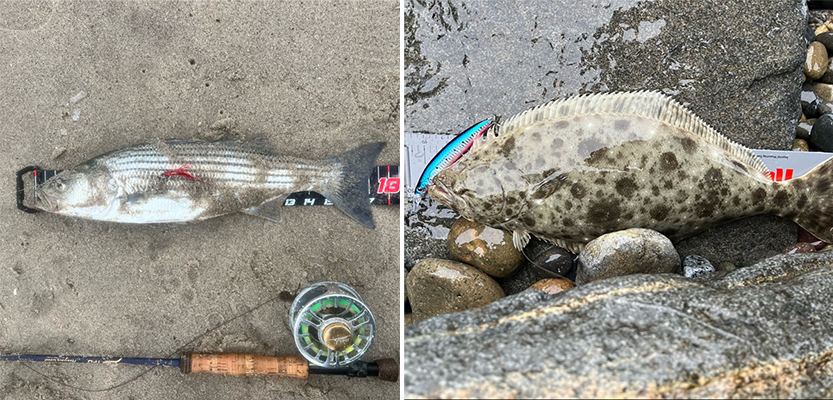
Category
Fly Tackle Division
Highest Daily Score Place 1st 2nd 3rd Angler Scott Yamamoto Lino Jubilado Laura Moronnolte Date 05/28/2023 06/04/2023 06/06/2023 Points 175 points 170 points 170 points Number of fish 23 fish 17 fish 22 fish Category
Regular Tackle Division
Highest Daily Score Place 1st 2nd 3rd Angler Glen Angelo Saldivar Sheldon Belhumeur David Escobosa Date 06/10/2023 05/28/2023 06/09/2023 Points 108 points 44 points 13 points Number of fish 10 fish 3 fish 1 fish 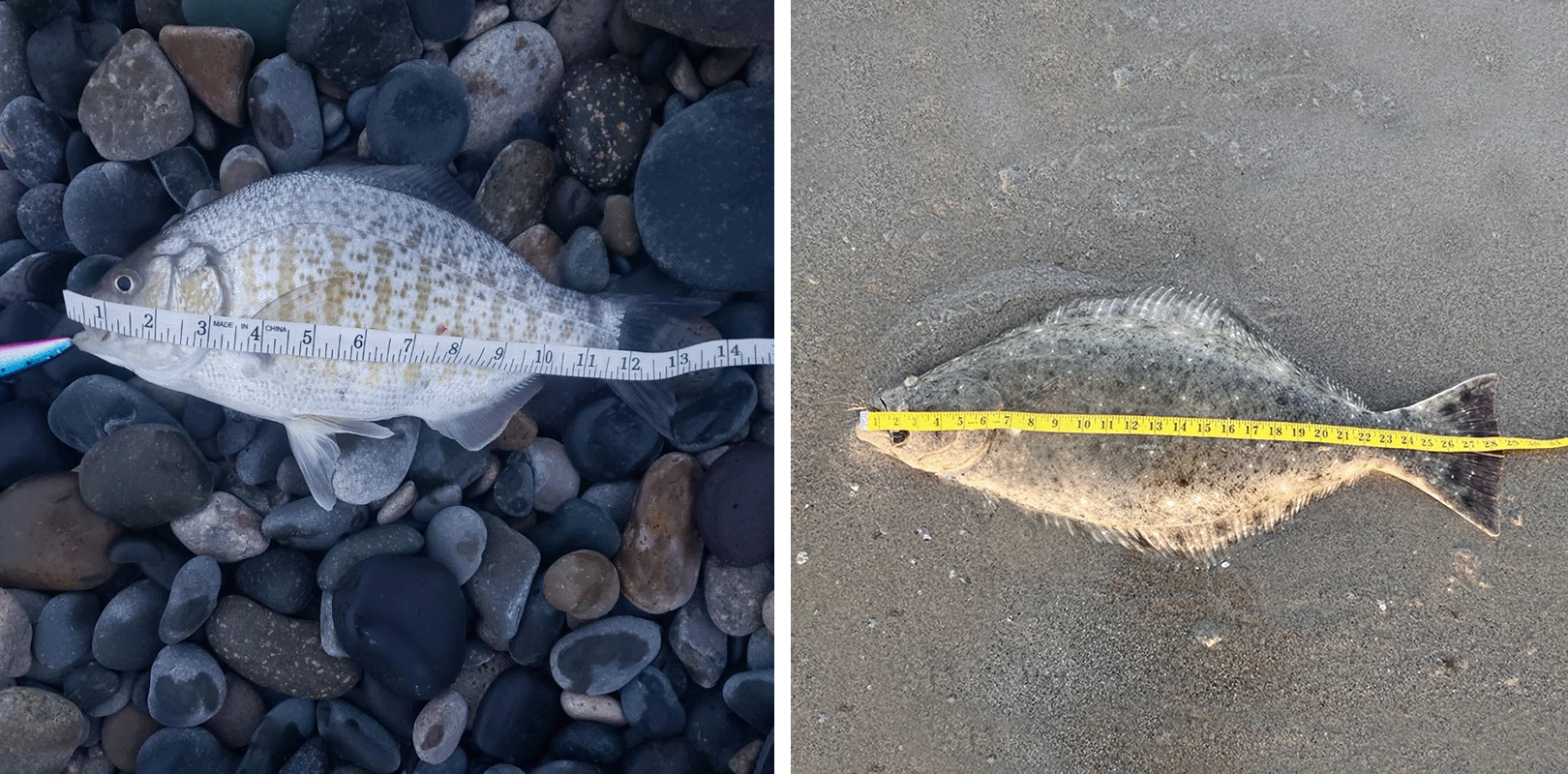
Category
Fly Tackle Division
Regular Tackle Division
Largest Fish Largest Perch Laura Moronnolte, Lino Jubilado, 13" Glen Angelo Saldivar, 14" Largest Corbina Laura Moronnolte, 22" David Escobosa, 10" Largest Spotfin or Yellowfin Croaker Derek Smith, Yellowfin Croaker, 17" Glen Angelo Saldivar, Yellowfin Croaker, 12" Largest Halibut Derek Smith, 29" Sheldon Belhumeur, 21" Largest Shark or Ray Largest Striped Bass Lino Jubilado, 17" There's still time to sign up! Click HERE to go to the registration page
-
Do You Measure Up?
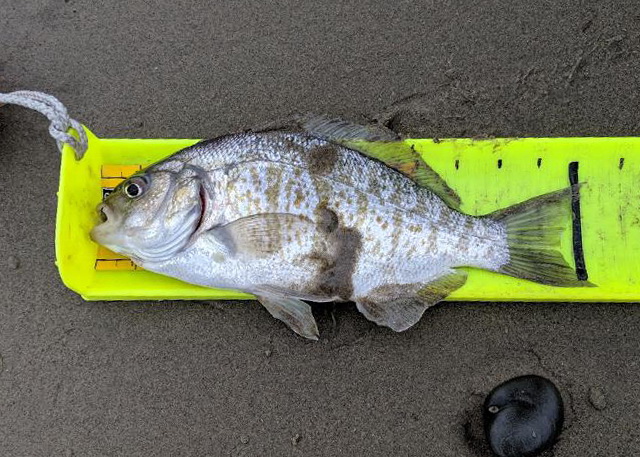
Now that fish submissions are coming in, a few things need to be highlighted:
- Your fish needs to be FLAT on the measuring device when you take the picture. Believe it or not, we view every picture submitted to verify the submitted length. If the fish is bent in the picture, we can't do that.
- It is HIGHLY RECOMMENDED that you put the fish's nose against the ruler's "bump stop", or at the 0" mark, rather than the other way around.
- The fish's length is measure at the tail fork, or the middle of the tail, if it is not forked.
- The length of the fish will be ROUNDED UP to the next inch mark for scoring purposes
-
Okuma Donates Regular Tackle Division Grand Prize!
We're happy to announce that Okuma Fishing USA has become the grand prize sponsor for the Regular Tackle Division! They are donating two rod/reel combos:
Combo 1: A Rockaway Surf Rod - model RSP-S-862ML (8'6", 6-12lb line), and a Ceymar reel - model CHD-2500HA
Combo 2: A Rockaway Surf Rod - model RSP-S-862ML (8'6", 6-12lb line), and an Inspira Blue reel- model ISX-30B
Each combo has an MSRP of approximately $200, and are well suited to the light-line style of surf fishing we use in Southern California. Here's some more info from the Okuma website:
ROCKAWAY SURF SP RODS
These rods are designed specifically for SoCal surf perch fishermen, and they're perfect for anyone who wants a lightweight and responsive rod that can handle big fish. The 24/30-ton carbon rod blank is sensitive enough to feel every bite, but tough enough to set the hook on those pesky predators. So whether you're fishing the surf or the open water, you'll be glad you had an Okuma Rockaway SP Surf Rod in your hand.The components on the Rockaway SP rods are well thought out. These rods are designed with a 50/50 tip over butt ferrule connection giving it a solid feel. They feature SeaGuide XQ series 316-stainless steel deep press guide frames that are designed to protect the inserts from the rough elements of surf fishing. The inserts themselves are Zirconium for both braided and monofilament lines. The Rockaway SP also has a SeaGuide stainless steel hook keeper, as well as a minimalized EVA split grip configuration to bring down the weight and keep you casting all day up and down the beach. Be sure to check out the entire lineup of Rockaway Surf Fishing rods.
CEYMAR HD SPINNING REEL
Okuma’s new Ceymar HD spinning reels are lightweight and feature-packed. These reels are constructed with a corrosion-resistant frame, side plate and rotor. From ultra-compact 1000 size reels to the perfect inshore 5000 size reel, the Ceymar HD might just be what you are looking for.Starting at just 6.9 ounces, these lightweight reels feature 7HPG +1RB stainless-steel ball bearings as well as a multi-disc, oiled felt drag system that puts out up to 20-lbs of drag. The Ceymar HD uses Okuma’s HDG-II High-Density Gearing, as well as a double ball bearing, supported machined brass pinion gear for the ultimate in smoothness. The machined aluminum, 2-tone anodized spool gives it a sleek look that matches up with the rigid machined aluminum screw-in handle.
There are eight total models within the Ceymar HD spinning reel lineup. 1000, 2500, 3000, 4000 and 5000 size all feature standard gear ratios of 5.2:1. There are also three high-speed reels in the 2500H and 3000H that have a 6.0:1 and the 4000Xa has a 6.2:1 gear ratio. All models have an interchangeable screw-in handle system that can be changed from left to right-hand retrieve
The Inspira Blue reels have these features:
• Cyclonic Flow Rotor
• TCA: Torsion Control Armor
• 8 BB + 1RB stainless steel bearings
• Quick-Set anti-reverse roller bearing
• Precision machine cut brass pinion gear
• Rigid, forged aluminum, anodized handle
• Light weight, EVA handle knobs for comfort
• Precision Elliptical Gearing system
• Machined aluminum, 2-tone anodized spool
• Heavy duty, solid aluminum bail wire
• RESII: Computer balanced Rotor Equalizing System
• Inspira spinning reels are backed by a 1-year warranty -
Riptide Rendezvous is Back for 2023!
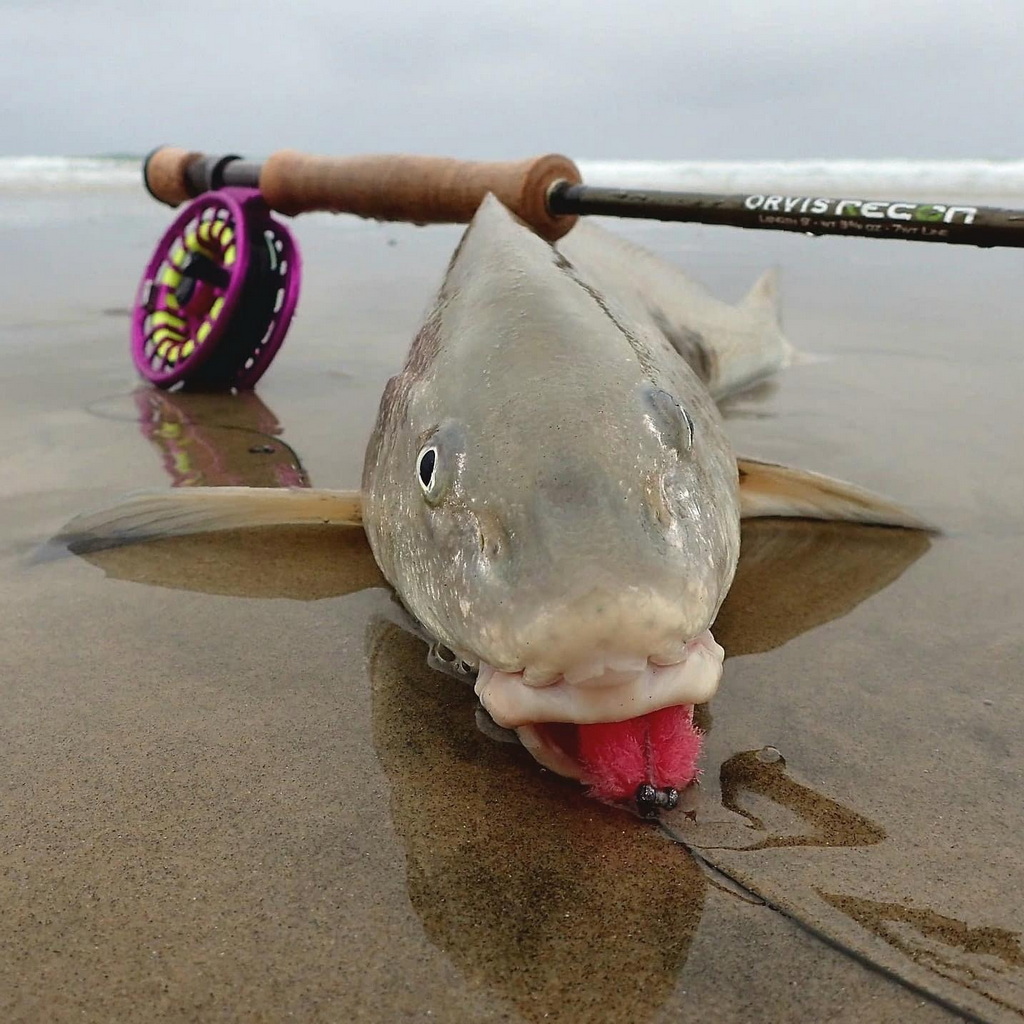 Photo by Glenn Ueda
Photo by Glenn UedaAfter three years of waiting for COVID-related issues to die down, we are happy to announce that Riptide Rendezvous will be back in 2023!
We're adopting an "all virtual" format this time around, which allows us to greatly expand both the time window and the geographic area covered by the event. You can fish any time from May 27, 2023 thru June 23, 2023, and anywhere from the northern border of Santa Barbara County to the Mexican border (as long as it's legal!)
One of the things that makes this possible is our continued use of the iAngler tournament app. All entries will be submitted by the contestants themselves when they catch a fish. That means you (or one of your fishing buddies) will need to have a smart phone to compete.
RR is still a Catch-and-Release only event, and as before, conventional tackle (spin, bait-casting) fishermen can compete in a separate division. Artificial lures or flies only.
In order to make this work, we are dropping the "one fly" feature in favor of a "use your own fly" format. See the complete rules HERE.
Have for questions or need more info? Visit our "Contact RR" page for phone number and email address
Ready to register? Click HERE to go to the registration page.


